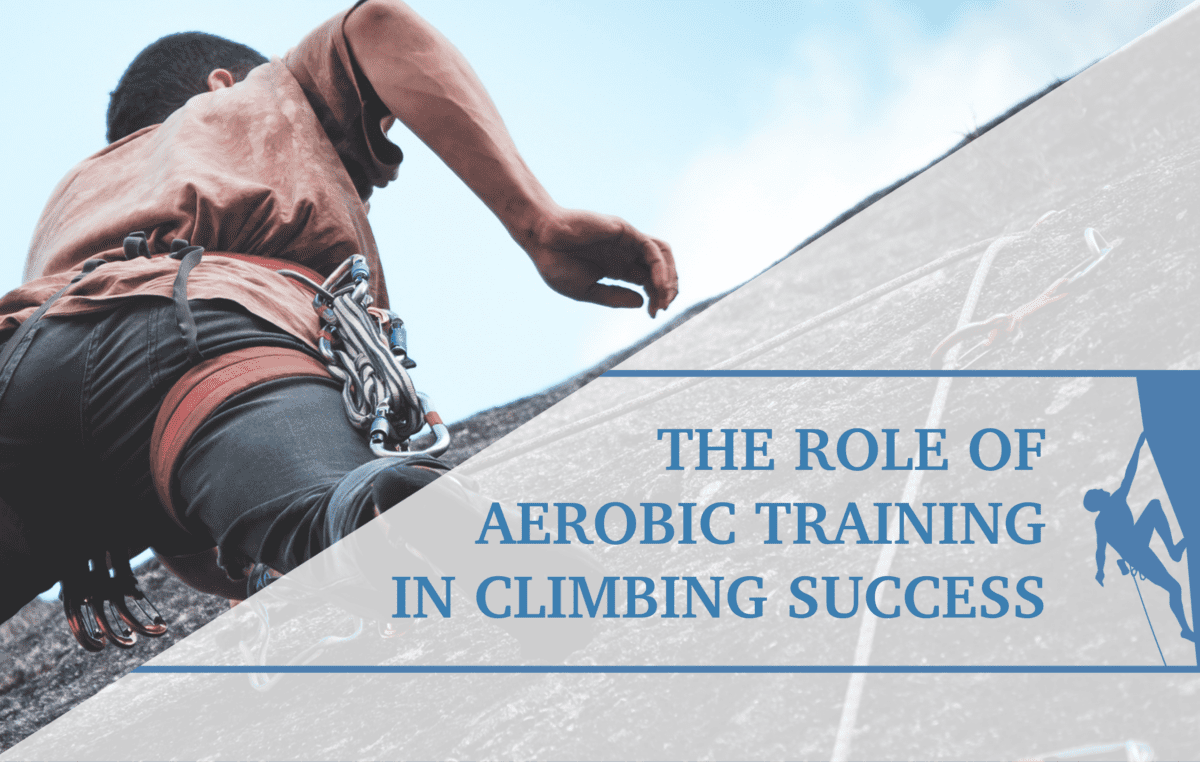Next Level Injury Prevention
As climbing becomes larger and more popular, climbing injuries will become more and more prevalent not only among the veterans, but also among newcomers. A simple google search will find hundreds of strengthening and stretching programs promising to bulletproof your shoulder, ankle, knee, etc…
Now I’m not here to denounce those strengthening and stretching programs, as I often will pick and choose which exercises I feel like I personally need in order to make me stronger, keep me from getting injured, or to help me send a project. I’m here to present a new dimension to your hopefully already present regimen and introduce thoughtfulness into your climbing movement.
This dimension I call the Movement Dimension. I like to conceptualize Strength, Mobility, and Movement as a Venn diagram; all contributing to Optimal Injury Prevention Strategies. Strength is the power and force your body can produce. Mobility is the range of motion your body is able to achieve.
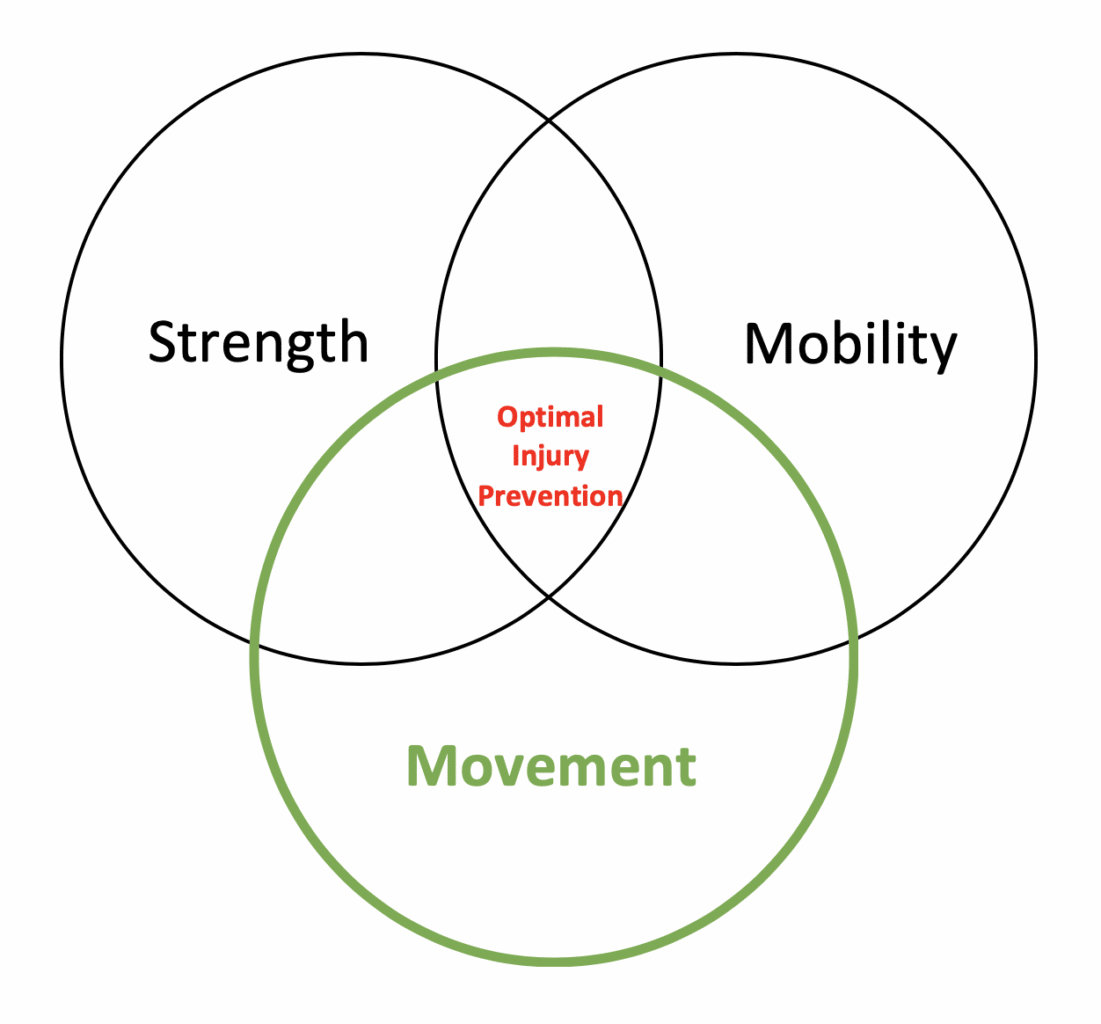
Now, when I say Movement I’m not talking about the sheer act of performing a reverse flag, heel hook, rose move, or drop knee; that’s what we call technique. I’m talking about the compilation of minute movements that happen through your core, shoulders, hips, knees, elbows, wrists, ankles, and fingers that work together to create the climbing techniques we know, and to make these climbing techniques seamless, natural, comfortable, and of course easy on your body.
Lower Extremity
In order to understand what movements we need to avoid or promote, we need to understand the most common climbing injuries. A 2019 study by Lutter et al.1, found 2 primary lower extremity injuries; to the medial meniscus and the iliotibial band (IT band). They also identified 4 Mechanisms of Injury; of which the heel hook, high step, and drop knee techniques being the main culprits (Figure 1).1
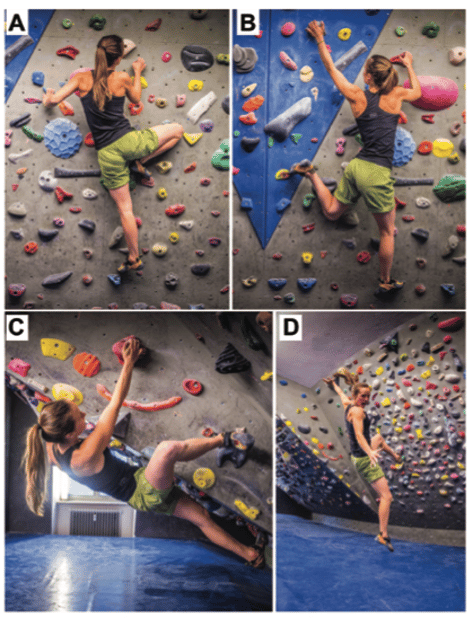
Although this study did not go into detail of biomechanical or specific causative movements to injury, previous research has shown the most common movement faults/contributors to medial meniscus and IT band injuries to be rotation through the knee joint on a foot which does not move from a set position ,when the knee is in flexion.2,3 Referring back to Figure 1 (our main culprits of lower extremity injury), we can also see that a heel hook, high step, and drop knee can introduce rotational forces to the knee joint while the foot is planted and the knee bent.
So how do we prevent this rotational movement in the knee when performing these techniques? Well it varies depending on what climbing technique is being utilized.
Heel Hook:
See the images below. As shown in both Figure 1c & 2a, the foot has been turned outward during the heel hook.
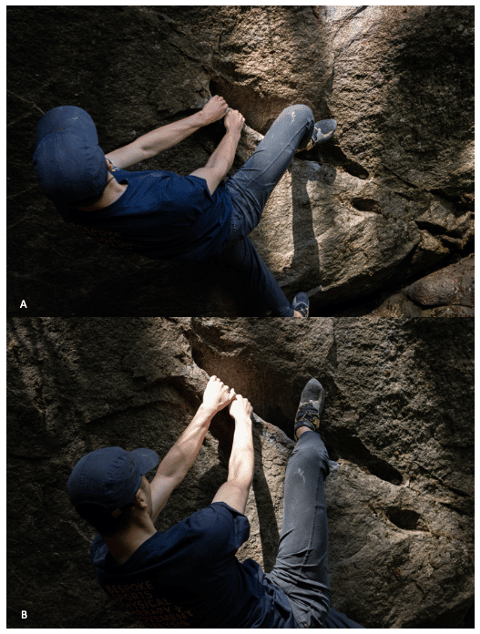
This positioning places soft tissue structures within the knee under tension and stress. Adding elements of body weight and the force it takes to make the next movement to the knee, it can be seen how the forces will remain directed onto supportive ligaments, and the meniscus. Figure 2B however, shows improved alignment between the femur and foot positioning, decreasing the angle, and therefore most likely decreasing rotational forces through the knee; placing load primarily through muscular structures.
How is this position in 2B achieved? The hip, a ball and socket joint, has significantly greater range of motion and is able to move in many more planes of motion than the knee, a hinge joint. By increasing hip external rotation and maintaining the knee and foot pointing in the same direction, the tension and stress can be primarily distributed to muscular structures.
Drop Knee & High Step:
Consistent with typical mechanisms of injury (MOI) to the inner knee structures from other sports (e.g. Soccer, football, etc.), it can be hypothesized that the MOI for climbing could occur as a result of a drop knee lacking appropriate amounts of hip and trunk rotation (Figure 3A), or pivoting on a high step where the ankle is in a fixed position (Figure 4A) causing excessive rotation through the knee joint.
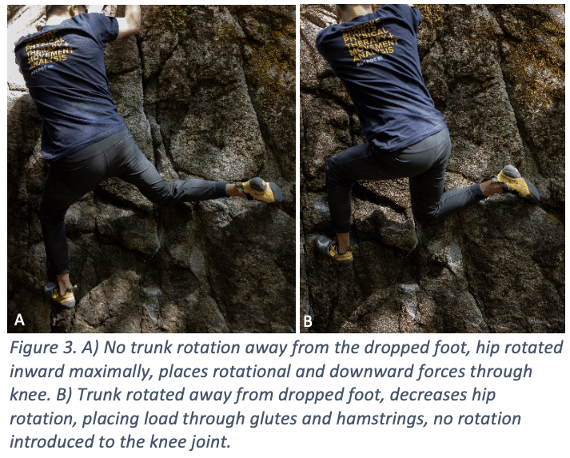
Simple technique fixes, such as turning your trunk away from the dropped knee and thereby maintaining hip/knee/ankle alignment in 1 plane (Figure 3B), and the placement/maintenance of the foot on a foothold so the toes are always in alignment with the knee (Figure 4B) would most likely transition forces away from the injury susceptible structures of the knee.
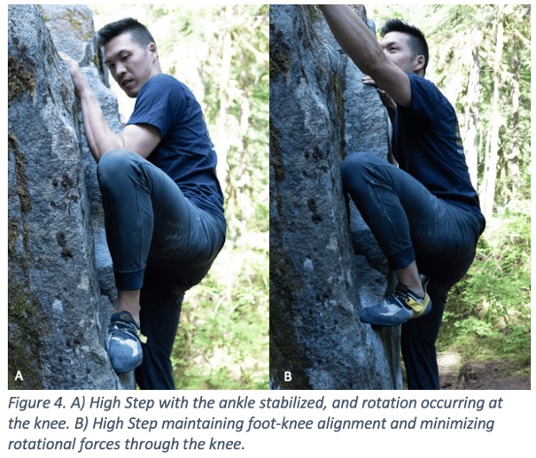
Upper Extremity
A 2018 study by Grønhaug G. found that 41.3% of climbing injuries involve the fingers. This is no surprise to the climbing community, however the study went on to show that prevalence of injuries not only start high (47% in recreational climbers) but remain high (61% in intermediate climbers, 58% in advanced climbers, and 56% in elite climbers).4 For this section, focus will be maintained on the elbows, wrists, and fingers.
When climbing, our forearms are usually rotated palms facing forward, and too often in higher intensities of crimping (Figure 5 C&D). This frequent positioning with the addition of high frequency and high intensity loading leads to a cascade of elbow, wrist, and finger overuse injuries that are completely preventable. Training how you move on the wall and selecting when to use varying levels of crimping can save you a lot of time and a lot of pain, so let’s review these.
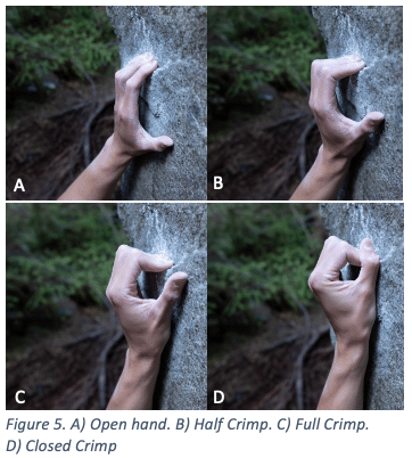
Medial/Inner Elbow:
While we typically only see the elbow as being “hinge-like”, many other factors come into play when we develop elbow pain. For instance, our forearms rotate; with arms out in front of you (like you’re climbing), the palms can be rotated away from you, towards you, and facing each other.
Typically, climber’s palms are pointing away from them (Figure 6A), placing the muscles of the inner elbow in a shortened position, and thereby placing greater load on them. Over time, this positioning with the high intensity of climbing will most likely lead to pain and inflammation of the tendons of the inner elbow (Medial Epicondylitis).5
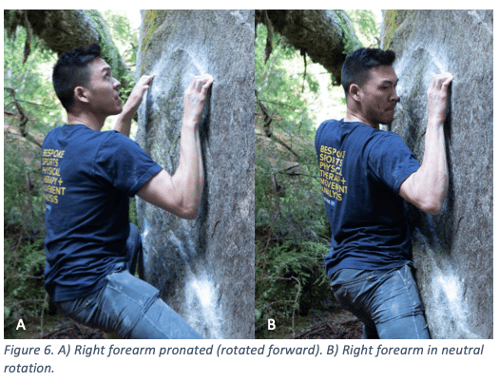
Luckily a simple movement change to our positioning can change the loading pattern. When on the wall, a neutral forearm rotation position is ideal (Figure 6B). So how do we achieve this neutral rotation? A basic understanding of neutral ranges, situations you can maintain neutral rotation, and minimizing time spent outside of neutral rotation is key. The 2 videos below depict the ranges of motion in which neutral forearm rotation can be maintained with elbows bent and straight positions.
Finger & Lateral Elbow:
Figure 7. Pulley Tendon Schematic.
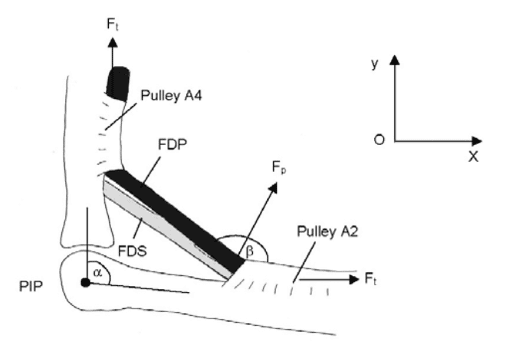
Climbers think about different grips a lot, but how many of us understand the benefits and consequences of each? We usually think about which grip will give us the most power and best sense of stability on a handhold, but then tend to use that one grip repetitively. Too often I see climbers full and closed crimping every single hold on a route, for the entirety of their climbing session; but little do they know the possible injuries they may cause by it. A study by Schoffl et al6 found (Figure 7),
“The force acting on the pulley is a consequence of the tension developed in the tendons as well as of the angle (β) between pulley and tendon (Roloff et al., 2006). As the angle (ß) decreases when flexing the finger (decrease of the angle between the proximal and middle phalange (α), the force acting on the pulley increases, explaining why the crimping position leads to ruptures more often than the hanging position.”
In other words, the greater the middle joint of the finger is bent (larger bend in the full and closed crimp positions), the higher the stress on the pulley tendons, and the higher the possibility of injury.
On top of possible injury to the pulley system, higher grade crimping can also lead to pain at the outside elbow (a.k.a. Lateral Epicondylitis). As shown in Figure 8, stronger crimping positions force the wrist further and further into extension. This is a natural phenomenon the body utilizes to stabilize the wrist in order to maximize grip strength. However overuse of the full and closed crimp grips may overload the muscles of the lateral elbow, and possibly result in pain at the lateral elbow.8
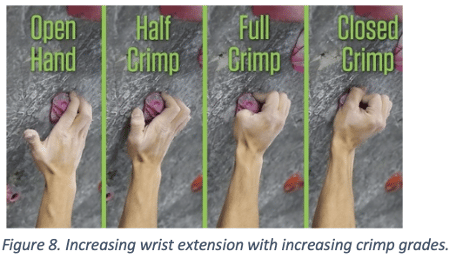
I’m sure some of you are thinking that I’m telling you to never ever use full or closed crimps ever again, but this is not true. I recommend climbers to think about these crimp types as a specialized tool in your belt; only needing it for a specific purpose. Training your open hand and half crimp positions and utilizing them much more often than the former can save you from a lot of pain and frustration, and keep you climbing (which is what everyone wants).
Movement is a powerful tool, that is too often ignored, and a valuable part of injury prevention. To paraphrase the author of Training for Climbing, Eric Hörst, Climbing is a skill sport and one has to climb and to get better. When we climb we are training our movement on the wall, so let’s be smart and deliberate about the way we move.
About the Author:
Dr. Andrew Chen, DPT is the Owner & Operator of RocDoc Physical Therapy in Seattle, WA; a home visit PT service focused on rock climbers and mountain athletes. He received his Doctor of Physical Therapy Degree from Washington University in St. Louis, a school that pioneered the Movement System Impairment Method and Diagnoses. This method analyzes minute movement patterns, links the movement patterns it to pain patterns, and corrects the movement pattern.
Andrew is a long-time climber of 13 years; primarily bouldering and proud sends of up to V11/12. He primarily works in the hospital at the University of Washington Medical Center and Swedish Medical Center, but runs RocDocPT as his passion project.

Website: https://www.RocDocPT.com
Email: Andrew.chen@rocdocpt.com
Sources
- Lutter C, Tischer T, Cooper C, et al. Mechanisms of Acute Knee Injuries in Bouldering and Rock Climbing Athletes. The American Journal of Sports Medicine. 2020;48(3):730-738. doi:10.1177/0363546519899931.
- Dressendorfer R. Iliotibial Band Syndrome. Richman S, ed. CINAHL Rehabilitation Guide. October 2018. http://search.ebscohost.com/login.aspx?direct=true&db=rrc&AN=T708411&site=eds-live. Accessed May 10, 2020.
- Dressendorfer R, Granado M. Meniscal Injuries (Nonsurgical Management). Richman S, ed. CINAHL Rehabilitation Guide. January 2020. http://search.ebscohost.com/login.aspx?direct=true&db=rrc&AN=T708409&site=eds-live. Accessed May 10, 2020.
- Grønhaug G. Self-reported chronic injuries in climbing: who gets injured when? BMJ Open Sport & Exercise Medicine2018;4:e000406. doi:10.1136/bmjsem-2018-000406
- Huber L, Granado M. Epicondylitis, Medial. Richman S, ed. CINAHL Rehabilitation Guide. June 2018. http://search.ebscohost.com/login.aspx?direct=true&db=rrc&AN=T708466&site=eds-live. Accessed May 18, 2020.
- Schöffl I, Einwag F, Strecker W, Hennig F, Schöffl V. Impact of Taping After Finger Flexor Tendon Pulley Ruptures in Rock Climbers. Journal of Applied Biomechanics. 2007;23(1):52. http://search.ebscohost.com/login.aspx?direct=true&db=edb&AN=23758809&site=eds-live. Accessed May 18, 2020.
- Brownstein B, Redavid L. Triangular Fibrocartilage Complex (TFCC) Tears. Richman S, ed. CINAHL Rehabilitation Guide. January 2020. http://search.ebscohost.com/login.aspx?direct=true&db=rrc&AN=T709242&site=eds-live. Accessed May 18, 2020.
- Lombara A, Granado M. Lateral Elbow Tendinopathy. Richman S, ed. CINAHL Rehabilitation Guide. November 2017. http://search.ebscohost.com/login.aspx?direct=true&db=rrc&AN=T708623&site=eds-live. Accessed May 18, 2020.
- Disclaimer – The content here is designed for information & education purposes only and the content is not intended for medical advice.


